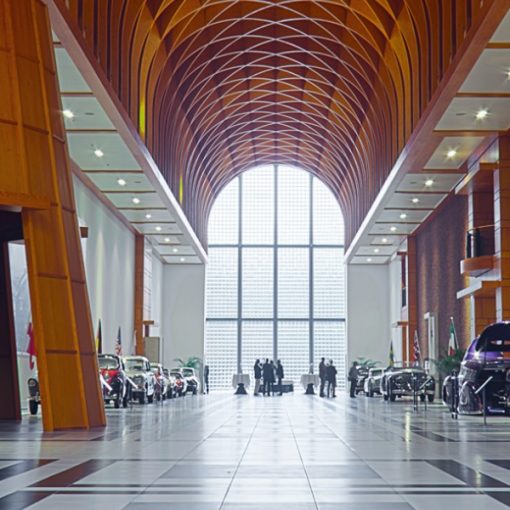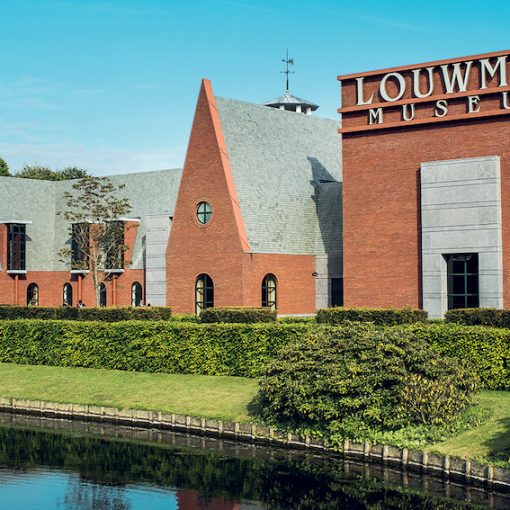A last look at the Louwman Museum
Welcome to our final review of the Louwman Museum in The Hague. Along the way, we will take in some fine examples of luxury, racing, lavish and downright odd designs from our motoring heritage. So, fasten your seat belts and enjoy the ride.
 Let’s first look at a few cars with celebrity and movie provenance because Genevieve is not the only star. The museum fielded two cars from “The Godfather” – a brightly coloured DeSoto Series S-11C Taxi and the 1941 Lincoln V12.
Let’s first look at a few cars with celebrity and movie provenance because Genevieve is not the only star. The museum fielded two cars from “The Godfather” – a brightly coloured DeSoto Series S-11C Taxi and the 1941 Lincoln V12.  The latter is displayed minus the bullet holes – two other stand-ins were used for that scene – whilst the former also starred in a later film entitled “Thieves”. As an aside, DeSoto, a sub brand of Chrysler, took its name from Hernando de Soto, a Spaniard who discovered the Mississippi River.
The latter is displayed minus the bullet holes – two other stand-ins were used for that scene – whilst the former also starred in a later film entitled “Thieves”. As an aside, DeSoto, a sub brand of Chrysler, took its name from Hernando de Soto, a Spaniard who discovered the Mississippi River.
 The customised 1976 Cadillac Fleetwood did not star in any films but its owner did, for it is the last Caddy that serial Cadillac buyer Elvis Presley bought before his untimely death in 1977. The illuminated running boards, Continental kit and vast dummy headlamps were, of course, in the best of possible taste.
The customised 1976 Cadillac Fleetwood did not star in any films but its owner did, for it is the last Caddy that serial Cadillac buyer Elvis Presley bought before his untimely death in 1977. The illuminated running boards, Continental kit and vast dummy headlamps were, of course, in the best of possible taste.
We’ll finish this section with arguably the most famous movie car of all, Bond’s Aston Martin DB5, displayed here with all Q’s devices installed.

In fact, this is most probably one of the two publicity cars made after “Goldfinger” was released in time for the release of “Thunderball”. Two cars were used in “Goldfinger”, the gadget-laden one and another used for the road shots. Sadly, the former was stolen in 1977 and never seen again. Coincidently the other publicity car sold recently for $6.385 M. The original road car has now been fitted with all the armaments from Q Branch and now resides in a private car museum in Ohio.
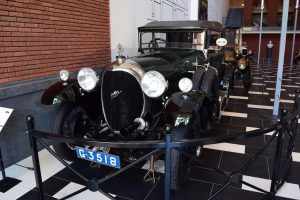 Luxury was the name of the game in the Twenties and Thirties and what caught this enthusiast’s camera lens did not disappoint. Since we are in Holland, let’s start with the 1922 home-grown Spyker C4 Coupe. Upholstered in fake snakeskin throughout, it housed a 5.7 litre Maybach engine below its extensive bonnet. Interestingly, it was fitted with a rear luggage rack with jagged edges to discourage juveniles from hitching a ride.
Luxury was the name of the game in the Twenties and Thirties and what caught this enthusiast’s camera lens did not disappoint. Since we are in Holland, let’s start with the 1922 home-grown Spyker C4 Coupe. Upholstered in fake snakeskin throughout, it housed a 5.7 litre Maybach engine below its extensive bonnet. Interestingly, it was fitted with a rear luggage rack with jagged edges to discourage juveniles from hitching a ride.
 Over a decade later an all-time great Mercedes Benz was born, the 500K Spezial Roadster. It has to be my favourite Merc. Of the 350 built, only 25 were Spezials. Originally owned by a (rich) London butcher – bought new in 1936 – he ran it until 1956 when he stored it in a barn. Thirty years later it was discovered, bought by a Swede, restored and has been a regular winner at Pebble Beach. It’s known as “The Butcher’s Car” for obvious reasons.
Over a decade later an all-time great Mercedes Benz was born, the 500K Spezial Roadster. It has to be my favourite Merc. Of the 350 built, only 25 were Spezials. Originally owned by a (rich) London butcher – bought new in 1936 – he ran it until 1956 when he stored it in a barn. Thirty years later it was discovered, bought by a Swede, restored and has been a regular winner at Pebble Beach. It’s known as “The Butcher’s Car” for obvious reasons.
 The French were also producing something special, not far from the German Border. Bugatti is well represented in the collection and two fine examples stood out for this scribe. The first is a 1932 black over red Type 50T Coach Profilee. Styled by Ettore’s son Jean, its engine design had elements of the American Miller racing engines incorporated into its 5.0 litre 8 cylinder power plant. The chassis was taken from a Type 46. This car is one of only two remaining. Sadly, Jean died in 1939 whilst testing a Type 57.
The French were also producing something special, not far from the German Border. Bugatti is well represented in the collection and two fine examples stood out for this scribe. The first is a 1932 black over red Type 50T Coach Profilee. Styled by Ettore’s son Jean, its engine design had elements of the American Miller racing engines incorporated into its 5.0 litre 8 cylinder power plant. The chassis was taken from a Type 46. This car is one of only two remaining. Sadly, Jean died in 1939 whilst testing a Type 57.

The other car produced two years later is a Type 57 Roadster “Grand Raid” Gangloff. With an aerodynamic streamlined body, it was a hit in the Paris Motor Show of 1934 and was later driven by Veyron and Wurmer in the Paris-Nice-Paris Rally.
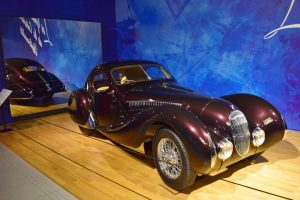 French glamour continues with the flowing lines of a couple of Talbot Lagos nearby. A 1937 T150 SS “Teardrop” Coupe and a later 1948 T26 Grand Sport both showing the unmistakeable lines of their designers, who, strangely enough, were not actually French. The T150 is by Figoni and Falaschi who were Italians who emmigrated to France and established their design and coach building business. Figoni and Falaschi’s flamboyant style graced several makes in their short but memorable reign. The Type T150 here was a real racer and with a 4.0 litre 160 hp six up front, powered to third place in the 1938 Le Mans race.
French glamour continues with the flowing lines of a couple of Talbot Lagos nearby. A 1937 T150 SS “Teardrop” Coupe and a later 1948 T26 Grand Sport both showing the unmistakeable lines of their designers, who, strangely enough, were not actually French. The T150 is by Figoni and Falaschi who were Italians who emmigrated to France and established their design and coach building business. Figoni and Falaschi’s flamboyant style graced several makes in their short but memorable reign. The Type T150 here was a real racer and with a 4.0 litre 160 hp six up front, powered to third place in the 1938 Le Mans race. 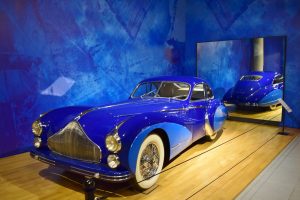 The later car is by Saoutchik, a Ukranian cabinet maker who set up shop in Paris in 1906. Instantly recognisable for his lashings of chrome and voluptuous wings, there are many examples of his work on marques from Delahay to Cadillac. [Note: I last saw this in the former Imperial Palace Museum, now closed, in Las Vegas.] As with other such coach builders, WW2 hastened their demise. Only 36 Grand Sports were manufactured and by the early 1950s, Saoutchik was no more. The 1950s also saw the demise of Talbot Lago having been bought by Simca in 1959.
The later car is by Saoutchik, a Ukranian cabinet maker who set up shop in Paris in 1906. Instantly recognisable for his lashings of chrome and voluptuous wings, there are many examples of his work on marques from Delahay to Cadillac. [Note: I last saw this in the former Imperial Palace Museum, now closed, in Las Vegas.] As with other such coach builders, WW2 hastened their demise. Only 36 Grand Sports were manufactured and by the early 1950s, Saoutchik was no more. The 1950s also saw the demise of Talbot Lago having been bought by Simca in 1959.

Style, glamour, power and fine quality were not exclusive to the Europeans. Those guys over the pond could more than keep pace. Take the Duesenberg Model SJ LaGrande dual-cowl phaeton of 1935, for example. On my Lottery Win list, it’s a real Duesy! This supercharged delight was bought new for $20,000, when your average Ford cost $500. Chassis and engine accounted for $8,500 of this whilst the coachwork by LaGrande lightened your wallet by a further $12,000. The supercharger was so big that the exhausts – nicely chromed – had to be placed outside the engine bay. Garbo, Gable, Cagney, Cooper, Mae West, Howard Hughes, Hearst and assorted European Royalty were all Duesenberg owners. The first person to die in a marque bearing their name was Fred Duesenberg when he crashed his car during speed trials. The SJ was their crown jewel, but, sadly, the Great Depression hastened the company’s demise in 1937 after around 35 were built.
 Cord and Auburn were parts of the same group and examples of both are on show. The ’37 Cord 812 Supercharged Beverly Sedan seen here was revolutionary in its time. Below that Art Deco body a 4.7 litre Lycoming V8 drove the front wheels which were independently suspended, the first American Car to feature this, much like the earlier Citroen Traction Avant. It also boasted an electro-pneumatic pre-selector transmission, with 4th gear overdrive and mechanically retractable headlights. It was nick-named “The Coffin Nose” for reasons you can see.
Cord and Auburn were parts of the same group and examples of both are on show. The ’37 Cord 812 Supercharged Beverly Sedan seen here was revolutionary in its time. Below that Art Deco body a 4.7 litre Lycoming V8 drove the front wheels which were independently suspended, the first American Car to feature this, much like the earlier Citroen Traction Avant. It also boasted an electro-pneumatic pre-selector transmission, with 4th gear overdrive and mechanically retractable headlights. It was nick-named “The Coffin Nose” for reasons you can see.  The Auburn 851 Speedster like the Cord, was designed by Gordon Buehrig and was probably one of his most beautiful designs. With a Schwitzer-Cummings centrifugal supercharger (it spun to 24,000rpm at maximum) the Speedster was the first American car to average 100 mph in trials. The museum’s model is the 852 version from 1936 which, although slightly modified is almost identical.
The Auburn 851 Speedster like the Cord, was designed by Gordon Buehrig and was probably one of his most beautiful designs. With a Schwitzer-Cummings centrifugal supercharger (it spun to 24,000rpm at maximum) the Speedster was the first American car to average 100 mph in trials. The museum’s model is the 852 version from 1936 which, although slightly modified is almost identical.
 The Great Depression’s impact on the American auto industry turned into a meteor strike in 1931 causing Packard to offer lower priced smaller vehicles for the first time in their history. But this did not stop them releasing the Eighth Series albeit with a shortened production run. With a 6.3 litre straight eight harnessing 120 horses, this Sport Phaeton offered refined cruising at over three figures. During that year, Packard brought the coach building in-house, thus increasing quality and operating margins. It also kept staff employed as the sales volumes dwindled. The display car features Pilot-Ray driving lamps (self-steering twin front fog lights) and an Adonis radiator mascot. Nice.
The Great Depression’s impact on the American auto industry turned into a meteor strike in 1931 causing Packard to offer lower priced smaller vehicles for the first time in their history. But this did not stop them releasing the Eighth Series albeit with a shortened production run. With a 6.3 litre straight eight harnessing 120 horses, this Sport Phaeton offered refined cruising at over three figures. During that year, Packard brought the coach building in-house, thus increasing quality and operating margins. It also kept staff employed as the sales volumes dwindled. The display car features Pilot-Ray driving lamps (self-steering twin front fog lights) and an Adonis radiator mascot. Nice.

If your passion is motor sport, then there’s plenty here to set your heart beat racing. There are far too many to list in this piece, but I’ll name check a couple that fired my interest. With over 140 rally and race wins, including the Mille Miglia, the BMW 328 of 1938 is up there with the best.
Alongside sit two Alfa Romeos – an 8C 2300 Le Mans Touring and a 6C 1500 Super Sport Works Team Car.
 Maserati had a whole row to themselves whilst bringing us into the later half of the last century were a Mclaren M8F and a Lancia-Arbarth LC1 Sports Spider.
Maserati had a whole row to themselves whilst bringing us into the later half of the last century were a Mclaren M8F and a Lancia-Arbarth LC1 Sports Spider.

For me the set with the most impact featured two actual Le Mans winners and both were British.
 On the left the 1935 winning Lagonda M45R which is completely original (surely it has had a paint job?) which took away Alfa’s potential five in a row victory at the famous track.
On the left the 1935 winning Lagonda M45R which is completely original (surely it has had a paint job?) which took away Alfa’s potential five in a row victory at the famous track.
On the right, as I’m sure you will have guessed is the Jaguar D Type 1957 winner.

Jaguar had pulled out of racing by then and this privately entered car for the Ecurie Ecosse Team was one of five that were entered. This car, driven by Flockhart and Bueb took an early lead and clung on to it making the victory three in a row for Jaguar. After the race, the car entered the club racing scene and following a crash ended up being split into two – body and rear suspension and front sub-frame and engine. Each half was given parts to replace the missing halves effectively forming two D Types out of one. The museum acquired both cars, took them apart and reunited the original pieces thus providing us with the original car that won Le Mans. Fascinating.
Let’s now look at a few oddballs – other than those I have previously described.
 The first appears quite ordinary, a Toyota. But this is the sole remaining example of Toyota’s first passenger car. (The one in the Toyota museum is a replica). It is unrestored and shown in the condition in which it was found, in Russia of all places. This model AA, was made from 1936 to 1943 with around 1400 being produced.
The first appears quite ordinary, a Toyota. But this is the sole remaining example of Toyota’s first passenger car. (The one in the Toyota museum is a replica). It is unrestored and shown in the condition in which it was found, in Russia of all places. This model AA, was made from 1936 to 1943 with around 1400 being produced.
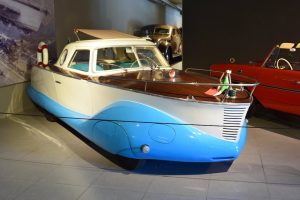 Nearby, the 1953 Fiat 1100 Boat Car takes some beating. It isn’t even seaworthy. Built by Coriasco of Turin, it was a publicity vehicle for a sailing school and came complete with wooden deck, port holes and life belts.
Nearby, the 1953 Fiat 1100 Boat Car takes some beating. It isn’t even seaworthy. Built by Coriasco of Turin, it was a publicity vehicle for a sailing school and came complete with wooden deck, port holes and life belts.
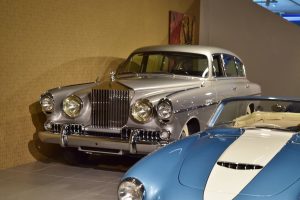 Rolls Royce didn’t escape the eccentric’s treatment as can be seen by this 1954 Silver Wraith Vignale. It came complete with chromed under bonnet piping, air-con, a bar, telephone and a mobile TV set (one of the first), white wall tyres, odd headlamps and…a gold painted WC in the back seat. It was only used for chilling champagne we are told. Thank God this was Vignale’s only design for Rolls.
Rolls Royce didn’t escape the eccentric’s treatment as can be seen by this 1954 Silver Wraith Vignale. It came complete with chromed under bonnet piping, air-con, a bar, telephone and a mobile TV set (one of the first), white wall tyres, odd headlamps and…a gold painted WC in the back seat. It was only used for chilling champagne we are told. Thank God this was Vignale’s only design for Rolls.
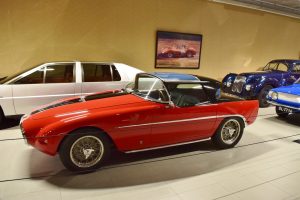 Less extravagant is the 1953 Fiat 8V Demon Rouge nearby. The shape of the rear screen and roofline immediately stand out and were designed to keep the rear window clean. The design won first prize in the “Coppa Campione d’Italia” Concours d’Elegance. This was the first and only eight cylinder car that Fiat made and had a production run of 114 units.
Less extravagant is the 1953 Fiat 8V Demon Rouge nearby. The shape of the rear screen and roofline immediately stand out and were designed to keep the rear window clean. The design won first prize in the “Coppa Campione d’Italia” Concours d’Elegance. This was the first and only eight cylinder car that Fiat made and had a production run of 114 units.
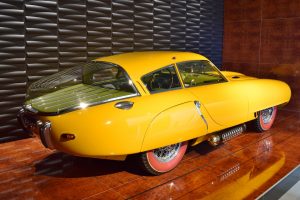 It would be hard to miss the bright yellow snappily named 1952 Pegaso Z-102 Berlinetta Enasa Cupula. Supposedly inspired by the flying saucer craze that was around at the time, it sported a massive domed rear window (or cupola), and red-walled tyres.
It would be hard to miss the bright yellow snappily named 1952 Pegaso Z-102 Berlinetta Enasa Cupula. Supposedly inspired by the flying saucer craze that was around at the time, it sported a massive domed rear window (or cupola), and red-walled tyres.  Parent company ENASA manufactured trucks in Spain under the Pegaso brand and in the 50’s tried their hand at sports cars. (well, Lamborghini did it). Unfortunately, the cars were too expensive and only around 100 were constructed. The company switched back to making commercial vehicles in 1957. Probably a wise decision.
Parent company ENASA manufactured trucks in Spain under the Pegaso brand and in the 50’s tried their hand at sports cars. (well, Lamborghini did it). Unfortunately, the cars were too expensive and only around 100 were constructed. The company switched back to making commercial vehicles in 1957. Probably a wise decision.
Finally, the car that started the collection, a 1914 Dodge, bought in 1934 by P W Louwman. Well, he was a Dodge dealer after all. This car featured a door mounted gradient meter, electric lights, a combined dynamo and starter motor and a “Fat Man” steering wheel which could be tilted so that drivers with a more generous figure could enter and exit more easily. This Type 30Touring car had an all steel body and is one of the oldest remaining in the world.
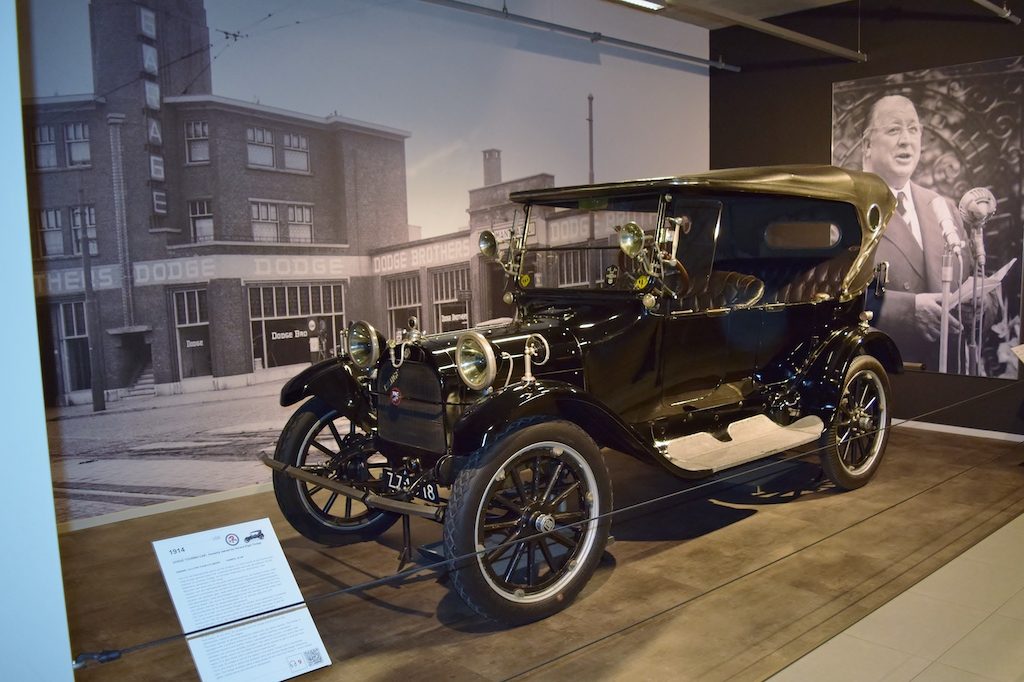
I am truly sorry that lack of space and time has meant that many superb and deserving exhibits in this entrancing collection have not been included in my narratives but, if you want more, The Hague is not really that far away. I leave you with some classic petrol pumps and period murals.


Neil Shanley


